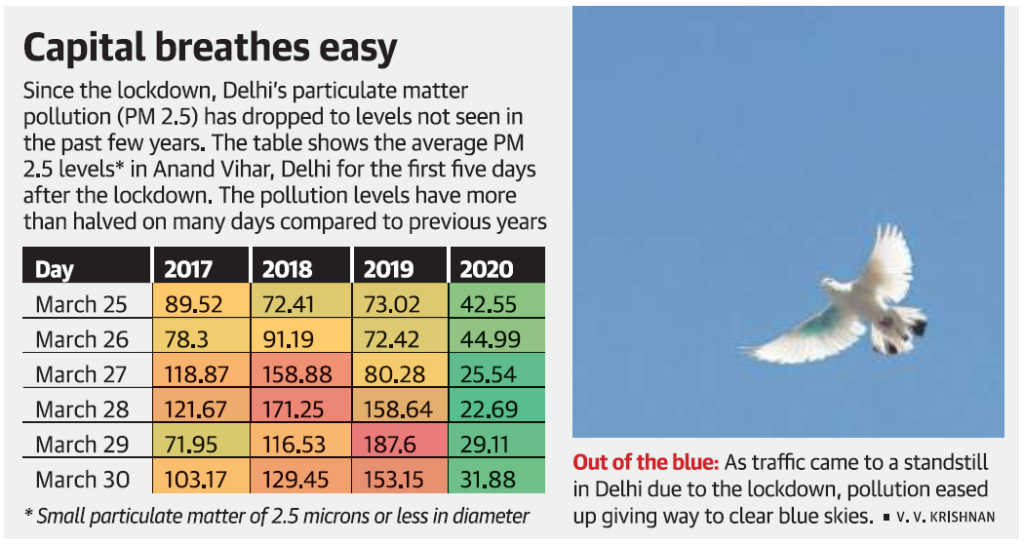Why in news?
The ongoing lockdown due to COVID-19 pandemic has pushed pollution levels in Delhi to a 5-year low and, across India, the number of cities that recorded ‘good’ on the air quality index jumped from 6 — on March 16 — to 30 as on March 29, according to data from the Central Pollution Control Board.
Details
- The CPCB in a report on the impact of the ‘Janata curfew’ on March 22, said that on the day before, AQI (Air Quality Index) was ‘Moderate (101-250)’ in Delhi.
- Overall, up to 44% reduction in PM10 levels was observed in Delhi during March 22-23, 2020, compared to previous day.
- The PM2.5 reduction was 8% on the curfew day but declined to 34% next day owing to negligible combustion activities on March 22-23, 2020, in and around the city.
- The key factor that triggered the decline was the number of on-road vehicles, which contributed to a 51% reduction in NOx levels and a 32% reduction in carbon monoxide levels during March 22-23 as compared to March 21.
- Research studies have attributed the key sources of PM2.5 in summer to be: dust and construction activities (35%), transport sector (20%) and industry (20%).
- During the lockdown PM10 and PM2.5 levels were reduced by about 35-40%. The cessation of industries contributed to this reduction by 10%, vehicles 10-15% and dust another 10-15%.

Other Factors?
- Unlike in the winter months, Delhi and other regions of the Indo Gangetic Plains generally tend to have better air quality in March, aided by consistent wind and sunlight, which help flush out pollutants.
- The impact of meteorological factors was partially favourable, however the reduction in air pollution can be largely attributed to transport and commercial-industrial restrictions, the CPCB said in its report.
What about other states?
- As on March 29, a total 91 cities were under ‘Good’ (0-50) and ‘Satisfactory (51-100)’ categories, with 30 cities with ‘Good’ AQI values.
- However, Lucknow, Muzaffarpur, Kalyan, Guwahati and Singrauli were under ‘Poor’ category during March 25-28.
- High emission levels in Lucknow and Guwahati were noted for PM2.5, attributable to ‘local’ combustion related activities.
- As on March 29, no city was under ‘Poor’ AQI (251-300) category.
Central Pollution Control Board (CPCB)
- The Central Pollution Control Board (CPCB) of India is a statutory organisation under the Ministry of Environment, Forest and Climate Change (Mo.E.F.C).
- It was established in 1974 under the Water (Prevention and Control of pollution) Act, 1974.
- Hence, it is a Statutory Body.
- The CPCB is also entrusted with the powers and functions under the Air (Prevention and Control of Pollution) Act, 1981.
- It serves as a field formation and also provides technical services to the Ministry of Environment and Forests under the provisions of the Environment (Protection) Act, 1986.
- It Co-ordinates the activities of the State Pollution Control Boards by providing technical assistance and guidance and also resolves disputes among them.
- It is the apex organisation in country in the field of pollution control, as a technical wing of MoEFC.
- The board is led by its Chairperson, who is generally a career civil servant from the Indian Administrative Service appointed by the Appointments Committee of the Cabinet of the Government of India.
- CPCB has its head office in New Delhi, with seven zonal offices and 5 laboratories.
Responsibilities and Activities of CPCB
- The board conducts environmental assessments and research.
- It is responsible for maintaining national standards under a variety of environmental laws, in consultation with zonal offices, tribal, and local governments.
- It has responsibilities to conduct monitoring of water and air quality, and maintains monitoring data.
- The agency also works with industries and all levels of government in a wide variety of voluntary pollution prevention programs and energy conservation efforts.
- It advises the central government to prevent and control water and air pollution.
- It also advises the Governments of Union Territories on industrial and other sources of water and air pollution. CPCB along with its counterparts the State Pollution Control Boards (SPCBs) are responsible for implementation of legislation relating to prevention and control of environmental pollution.





